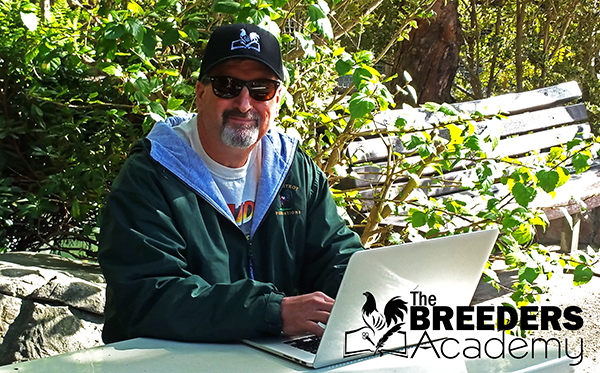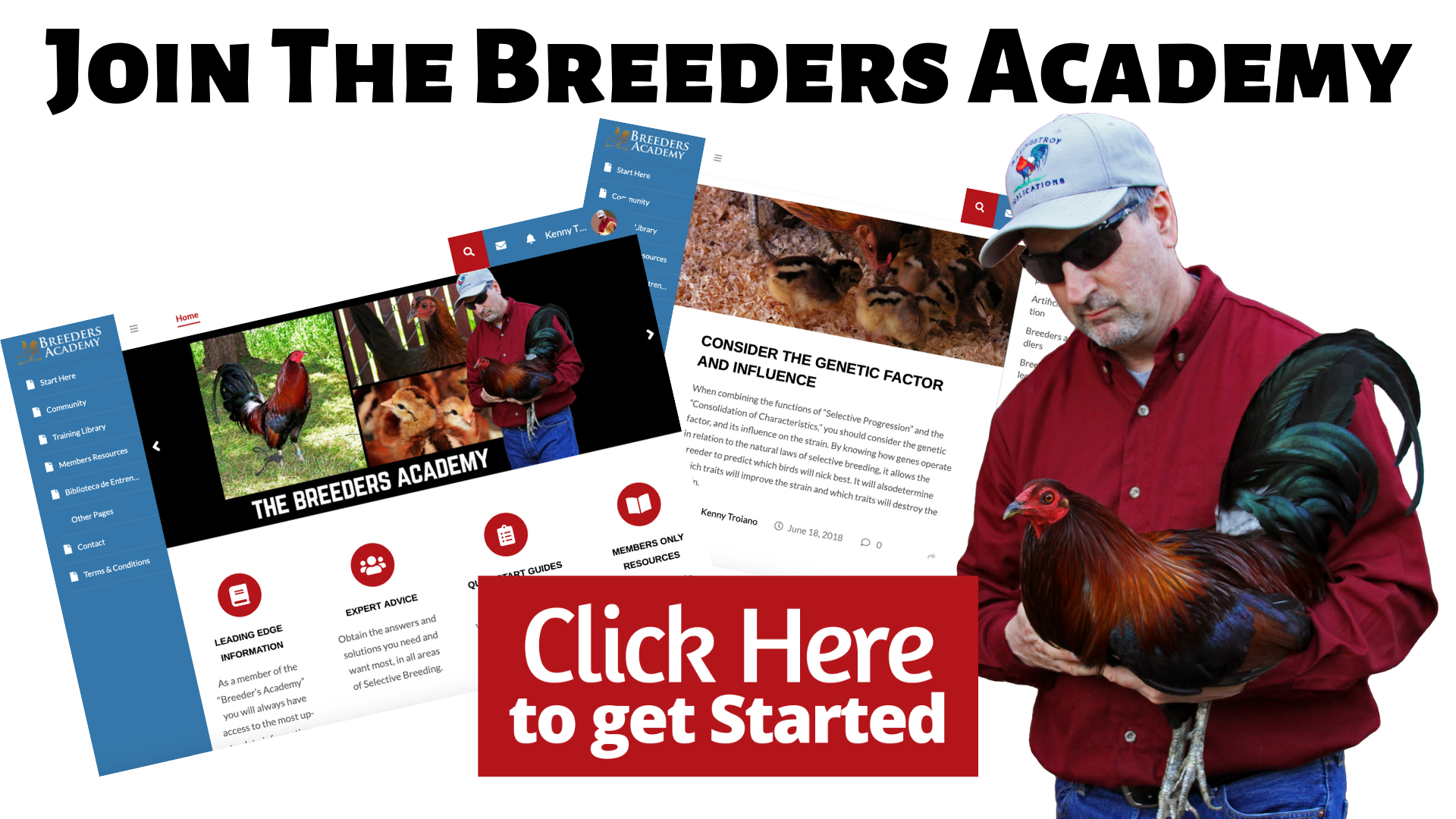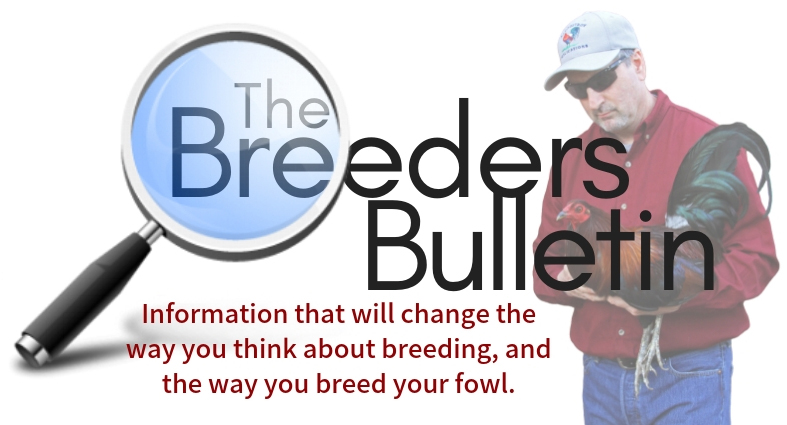 The True Meaning of the Word “Pure”: Breeding has improved so much from when I was a kid. Part of the reason why is because good fowl were harder to obtain back then. We were forced into getting what we could from friends – a little of this and a little of that, blending them together in the hopes that we might develop something that was competitive. Pure blood was relatively nonexistent. We had to make our own pure lines.
The True Meaning of the Word “Pure”: Breeding has improved so much from when I was a kid. Part of the reason why is because good fowl were harder to obtain back then. We were forced into getting what we could from friends – a little of this and a little of that, blending them together in the hopes that we might develop something that was competitive. Pure blood was relatively nonexistent. We had to make our own pure lines.
Today we are afraid to use the word “Pure.” However, now days the better fowl are easier to obtain, and more and more breeders are getting into the breeding and development of their own strains. And, if this keeps up, I believe the improvements made in breeding and the knowledge gained in modern genetics are going to make the meaning of “pure” a reality, which means we need to redefine this term once more.
The difficulty with the way in which some people currently use the word “pure” in breeding is that it’s simply wrong. What happens is most will buy a Hatch cock from a well-known breeder in California and then buy a Hatch hen from another breeder in Alabama, they breed the two, and then assume what they have obtained in the offspring is pure Hatch. They may be Hatch, but they are not pure in any sense of the word. And, there are a lot of reasons for this
First of all, the originator of the Hatch fowl, Mr. Sandford Hatch, died many years ago. This means that the California and Alabama breeders would have had to breed their Hatch fowl without the use of any outside blood, and would have done so without any further access to Mr. Hatch’s original stock for over fifty or so years.
If I were to buy fowl from these gentlemen I would only have their word that they have maintained the purity of their Hatch fowl during all that time. If they had infused fowl from other breeders, into their Hatch family, at any time, I would probably never know it. Not only that, but it is well known that Mr. Hatch bred a large number of lines that were unrelated.
What if the Alabama breeder had obtained one of the lines, and the California breeder had obtained another unrelated line. Where would that leave me in my attempt to breed a pure Hatch family? For example, most breeders know that because of Heinie Mathesius, who worked for Mr. Hatch, and bred the yellow-legged Hatch fowl, had heavy infusions of Boston Roundhead blood in them. They are called Hatch, but in actuality have very little Hatch blood in them.
The California and the Alabama breeders, who live so far away from each other most likely selectively bred their particular Hatch lines to suit their own personal preferences, especially in regards to conformation of body, temperament and performance abilities. The chances of these two people having worked together for the same common goals are very slim.
The California breeder might prefer a dark-red bird with a pea-comb that has a higher station, and looks for fowl that are high flyer’s and are extremely smart, while the Alabama breeder might prefer a light-red bird with a single-comb that has a medium-station, that stays on the ground. In this case, breeding a Hatch cock from the California breeder to a Hatch hen from the Alabama breeder would likely bring about offspring with a variety of characteristics and performance abilities. Some would be pea-combed and others single-combed; some would be high-stationed, while others are medium-stationed; some would be dark-reds, and others light-reds.
So, I ask you, in what sense would they be pure? This person would be better off buying fowl from one or the other, not both!
Pure Lines vs. Genetic Variation: One thing I have learned from the best breeders in the world is that they are not afraid to inbreed or line-breed to produce or maintain pure lines. Inbreeding or line-breeding from a closed family of fowl can reduce the variation in the looks and performance ability of the offspring.
This is where the change I was talking about has occurred. As more and more breeders are getting interested in developing their own lines, in order to be consistent with the current knowledge of chicken genetics, we will eventually have to use a newer and more boundless meaning to the term “pure.”
It is true that chickens have the greatest number of genes and chromosomes of all living beings and this is why it is difficult to breed them to be genetically pure, but not entirely impossible.
Inbreeding or line-breeding lessens the genetic variation that comes from crossing different lines, and although, it does not lessen the inherent genetic variation that all chickens possess, that is fine, for this is where improvement is made, through variation.
Remember variation makes selection possible and selection makes improvement possible. At first variation between parents and offspring, and that with siblings are large, but in time will become uniform and consistent.
Each cock or hen has thousands of genes that are in pairs. Most of these pairs are heterozygous, which means that the two genes in the pair are different from each other.
A cock or hen passes only one gene from each of its thousands of pairs whenever it breeds. At first there can be extremely large possible combinations of pairs of genes, which a chick can get from both parents. Even the most inbred or line-bred matings will produce an assortment of offspring in looks and performance abilities. But, the closer bred they are, the more consistent they will become.
Some breeders don’t breed for looks, because they feel that it is nothing more than a waste of time. Although, appearance doesn’t makeup the bird, it does add to the fowls overall uniformity and consistency, and in turn effects their production and performance abilities as a family.
It’s a matter of predictability. For instance, if you like single-combs, you should breed a single-combed cock to a single-combed hen. Since single-combs are recessive, all single-combed fowl have homozygous pairs of genes for this quality. By breeding only single-combed fowl, you will eliminate any genes for pea-comb. This way you can perpetuate this quality in your fowl and you can honestly say that your fowl are “pure” for single-combs, since they only carry that gene. You have just made them predictable. This works for other traits as well.
At some point, all cocks and hens in the breeding line will be good to excellent and when bred will pass on this quality to their offspring, and if continued, will become consistent as a family, and in all reality will be pure!
Testing your fowl for Genetic Purity: If given a reliable record of a bird’s ancestry, the breeder can be reasonably confident of how it is going to reproduce in terms of simple features. Quite often, however, birds are obtained by an exchange of a more informal basis, there is no paper work proving his ancestry. We’re forced into taking the breeders word as truth. Our birds may come from a batch where only two or three may have shown some promise. In this case, it might be a good idea to test them for their genetic purity.
This form of testing relies on you the breeder, breeding the unknown to the known and studying its progeny. Taking the new unknown bird and breeding it to a bird you have full knowledge of.
We know that a bird with recessive characteristics such as a single-comb must be homozygous. The bird under test will of course show its dominant factor, such as a pea-comb. If it is also pure, and the two are bred, all the offspring will carry the dominant characteristic, in this case, the pea-comb. A heterozygous bird, on the other hand, bred to the pure recessive, will produce approximately fifty percent of the chicks with single-comb (a recessive factor) and fifty percent with pea-comb (a dominant factor). Breeding birds in this manner and using a Punnett’s Square will let you know exactly what you are dealing with, and how you should breed them in the future.
The Breeders Natural and Unavoidable Tendency to Experiment: The usual assumption, especially for the beginners, is that breeding is a simple endeavor, a matter of putting a cock with a hen. Some like to call it “Common Sense Breeding.” In really breeding good fowl is much tougher than they realize. This kind of thinking can be extremely hazardous because it encourages breeders to be careless, and it promotes haphazard breeding practices regardless of the results.
It’s the successful breeder who knows that breeding involves the continuous modification of their breeding practices, and at times their brood fowl.
The only breeders that are likely to succeed are those who are willing to utilize the experimental methodology to breeding. An approach, such as this, will permit the breeder to cull, not only his weak and substandard individuals, but also his mediocre ones, and when necessary, will allow you to bring in better-quality fowl as replacements.
An approach, such as this will assure the continued improvement of the strain in development. It will also allow you to quickly identify problems in your breeding program, and adopt a method that will work for you and your fowl, such as out-crossing when your line-breeding program is running into problems, or changing your methods for managing the farm, such as their daily rations.
The natural difficulty of procreation makes all breeding experimental in nature. Although, this is especially true of first time matings, even proven matings will vary in the quality of their offspring from year to year, usually due to changes in their environment.
Results in breeding are determined by the combination of genes of both parents. When a particular mating fails to produce the desired results, it could be due to one of the following reasons: the cock is a poor brood cock; the hen is a poor brood hen; both are poor brood fowl, or both are good, but the combination of the two just doesn’t work. If for some reason you feel that it is worth the effort to save one or both of the brood fowl, the only way to make sure is to do some controlled experiments. The cock and the hen should be bred with other brood fowl, and the offspring from these matings should be evaluated, and it is this evaluation that will determine the worth of the brood fowl, and where the breeder should make his final decision.
For the breeder, inbreeding and line-breeding procedures are very important, but can be dangerous if they are not changed when the results obtained have become unsatisfactory.
Sticking to preconceived plans even when they go bad is the wrong approach. The better way is to evaluate each generation carefully, and make the necessary adjustment when needed. Only successful matings should be continued, and only the best generations should be bred from.
The best thing a breeder carries with him is knowledge, it’s the best tool in his tool box. That tool box has in it the knowledge of selection; sound breeding practices; farm management; and good all year-round care. Maybe the most valuable tool a breeder carries with him is the importance of careful observation and evaluation of the offspring.
The performance of the progeny should be observed and evaluated at various stages of their development, this will not only prove the parents worth, but will also show their hatching rate, survivability, their physical and mental attributes, and their production ad performance abilities.
It is important that evaluations be done with great objectivity, and that no preconceived notions are introduced just because the breeder has a partiality for a particular brood cock or brood hen. Accurate records of all the offspring are essential in the evaluation process.
It takes a lot of patients and years of breeding to develop a good strain. The desired characteristics have to be recognized, united and established over many generations to be successful. In the process, no matter how good or how experienced you are, you, the breeder, are going to make many mistakes. The experienced breeder is always prepared for the fact that only some of his matings will succeed and others will fail. Knowing this should keep you from becoming discouraged as you strive for excellence in your breeding program.

